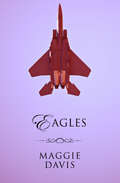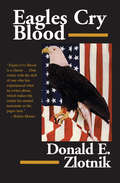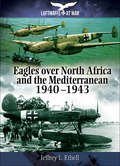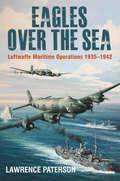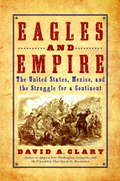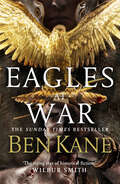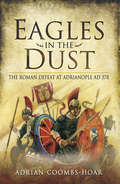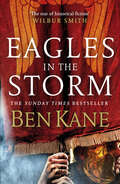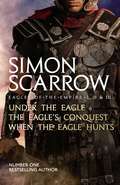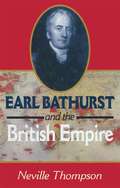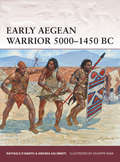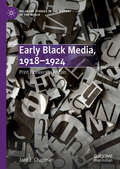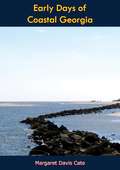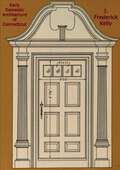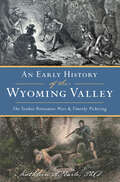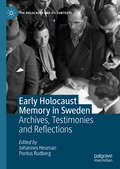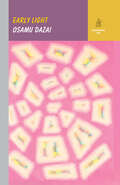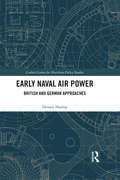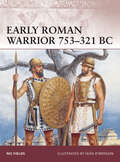- Table View
- List View
Eagles
by Maggie DavisA thrilling novel of military lives—and loves—as USAF pilots ignite the engines of their F-15 Eagles and take to the skies. They are intoxicating seductresses willing to do anything—absolutely anything—for love; however, these women can't rival the military aspirations of their men. The women try to fill the holes left in their hearts, but how much longer can they survive loneliness and rejection? How do they take possession of their men's hearts, hearts that only have room for the liberating expanse of the sky? The only way they can reach their stuck-in-the-clouds men is to use illicit affairs, sinful seduction, and murder—to fly like EAGLES.
Eagles Cry Blood
by Donald E. ZlotnikWhile too many soldiers are fighting for the brass in the midst of the bloody Vietnam battles, Lt. Paul Bourne is compelled to fight the enemy for his country&’s freedom. But when he comes up against his captain--a man driven by selfishness and a desire for recognition and glory, Bourne is even more determined to destroy the enemy--even if this means sacrificing his life.
Eagles Over North Africa and the Mediterranean, 1940–1943 (Luftwaffe at War)
by Jeffrey EthellAlthough the Luftwaffe achieved a great deal of success in North Africa between 1940 and 1943, it was hampered by the constant demand for men and machines elsewhere, logistical problems, such as a crippling lack of fuel, and the harsh desert conditions. An impressive selection of photographs from archives and private collections reveal the German and Italian aircraft used and developed in this theatre as well as the people involved. With insightful captions and supporting text, this offers a fascinating perspective on the Luftwaffe at war.
Eagles Over the Sea: Luftwaffe Maritime Operations 1935–1942
by Lawrence PatersonThe arduous development of a dedicated naval air arm for Germany&’s resurgent military was fraught with the kind of fierce inter-service rivalry that was rife throughout the turbulent history of the Third Reich. However, almost despite the odds, a small dedicated maritime strike force was assembled, germinating during the Spanish Civil War before being committed to action from the first days of the invasion of Poland. Concurrently, the operational Luftwaffe developed its own maritime units that would eventually subsume all of the Kriegsmarine-controlled formations as the war years progressed. This new book by the well-known author of German naval operations in WWII offers, for the first time, an in-depth study of all the Luftwaffe maritime operations. This is the first of two volumes and takes the story up to 1942. The story of Luftwaffe maritime operations has frequently been written about in fragmentary terms, delineating between the planned naval air arm operating under Kriegsmarine direction and the &‘operational Luftwaffe&’. Each branch of service — and even aircraft type — has usually been studied in isolation. This book, however, broadens the lens to study the development of German naval aircraft as a whole, not as separate independent services but rather as a concerted attempt to engage the enemy at sea in every theatre of operations, from Norway and Western Europe to the Mediterranean and the Eastern fronts, and, of course, over the Atlantic. Through ship-board aircraft, torpedo bomber attacks, minelaying and reconnaissance missions, Luftwaffe maritime aircraft played a vital role in Germany&’s naval war and the author analyses all the operations and the successes in the early years of the War. This first volume ends in 1942 when, despite great success, petty rivalry and naked arrogance combined to foreshadow the eventual defeat of the Luftwaffe&’s war at sea. Heavily illustrated throughout, this detailed and exciting operational history will be of huge appeal to both naval and aviation historians and enthusiasts.
Eagles and Empire: The United States, Mexico, and the Struggle for a Continent
by David A. ClaryClary, a historian who has worked for the US Forest Service and consulted for the Departments of Defense, Interior, and Agriculture, provides a history of the Mexican-American War (1846-1848) that draws on primary sources from both sides and addresses the political and social tensions that caused the conflict. He provides historical background on the two countries since 1783, and details the roles of President James Polk and dictator Antonio López de Santa Anna; explorers John Charles Frémont and Kit Carson; and soldiers like future president Zachary Taylor, who fought in events such as Alamo and in raids, guerilla attacks, and battles. The aftermath is also discussed briefly, as are Mexico-US relations up to 2008. Annotation ©2009 Book News, Inc. , Portland, OR (booknews. com)
Eagles at War (Eagles of Rome #1)
by Ben KaneONLY THE GODS CAN SAVE THE ROMANS NOW AD 9, Germania. East of the river Rhine, tribes hostile to Rome prepare a deadly ambush. Their leader is the charismatic chieftain and trusted ally of Rome, Arminius, whose dream is to drive out the brutal invaders of his land. Pitted against him are veteran centurion Lucius Tullus and the Roman provincial governor, Varus.Together with three local legions, they leave their summer camp to begin the march back to the Roman forts on the Rhine.They have no idea that in the forests and bog of the Teutoburg, mud, slaughter and bloody death await …‘This is historical fiction at its best' Sunday Express'Held me spellbound to its spectacular bloody end' Manda Scott'Gripping, brutal, brilliant' Giles Kristian
Eagles in the Dust: The Roman Defeat at Adrianopolis AD 378
by Adrian Coombs-HoarIn AD376 large groups of Goths, seeking refuge from the Huns, sought admittance to the Eastern Roman Empire. Emperor Valens took the strategic decision to grant them entry, hoping to utilize them as a source of manpower for his campaigns against Persia. The Goths had been providing good warriors to Roman armies for decades. However, mistreatment of the refugees by Roman officials led them to take up arms against their hosts. The resultant battle near Adrianopolis in AD378, in which Valens lost his life, is regarded as one of the most significant defeats ever suffered by Roman arms. The Roman historian Ammianus Marcellinus called it the worst massacre since Cannae, nearly six hundred years previously. Modern historians have accorded it great significance both at a tactical level, due to the success of Gothic cavalry over the vaunted Roman infantry, and in strategic terms, often citing it as the beginning of the end for the Empire. Adrian Coombs-Hoar untangles the debate that still surrounds many aspects such claims with an insightful account that draws on the latest research.
Eagles in the Storm (Eagles of Rome #3)
by Ben KaneAD 15. The German chieftain Arminius has been defeated, one of the lost Roman eagles recovered, and thousands of German tribesmen slain. Yet these successes aren’t nearly enough for senior centurion Lucius Tullus. Not until Arminius is dead, his old legion’s eagle found and the enemy tribes completely vanquished will he rest. But Arminius – devious, fearless – is burning for revenge of his own. Charismatic as ever, he raises another large tribal army, which will harry the Romans the length and breadth of the land. Soon Tullus finds himself in a cauldron of bloodshed, treachery and danger. His mission to retrieve his legion’s eagle will be his most perilous yet…
Eagles of the Empire I, II, and III: UNDER THE EAGLE, THE EAGLE'S CONQUEST and WHEN THE EAGLE HUNTS
by Simon ScarrowAvailable together in one ebook volume for the first time, three of Simon Scarrow's action-packed novels of the mighty Roman army. Introducing heroes Macro and Cato - for everyone who loves tales of courage and camaraderie from the days of the Roman EmpireIF YOU DON'T KNOW SIMON SCARROW, YOU DON'T KNOW ROMEPraise for the Eagles of the Empire novels: 'I really don't need this kind of competition... It's a great read' Bernard Cornwell 'Rollicking good fun' Mail on Sunday'It's Spartacus meets Master and Commander in this rip-roaring, thoroughly entertaining tale of swashbuckling adventure from one of the most exciting writers of historical fiction' Scottish Daily RecordUNDER THE EAGLE (Eagles of the Empire I) AD 42, Germany. New recruit Cato is finding life in the Roman Second Legion brutal. Promoted above his comrades thanks to his connections, he's resented by the other men. He could really use a friend amongst his fellow soldiers right now. A brave and determined soldier, Cato quickly earns the respect of his Centurion, Macro, a battle-hardened veteran. On a campaign to Britannia - a land of utter barbarity - an enduring friendship begins. But as they battle to thwart a conspiracy against the Emperor the men find themselves in a desperate fight to survive... THE EAGLE'S CONQUEST (Eagles of the Empire II) Britannia, AD 43. Britannia is bleak, rainy and full of vicious savages. As right-hand man to Centurion Macro, young soldier Cato battles alongside his commander in bloodier combat than he could ever have imagined. But the Britons are fighting back with Roman weapons - which means someone in their own ranks is supplying arms to the enemy. Cato and Macro are about to discover even deadlier adversaries than the British barbarians... WHEN THE EAGLE HUNTS (Eagles of the Empire III) Britannia, AD 44. Cato and Macro are pawns in Rome's lust to conquer Britain. During the freezing winter, the two men and their legion fight the bloodthirsty natives in hand-to-hand battles that haunt Cato for days afterwards. But in a place full of enemies, the most vicious are the Druids of the Dark Moon; brutal men who have captured the wife and children of General Plautius. Macro and Cato must travel deep into enemy territory and recover the hostages. The fate of the Roman army depends on the outcome...Readers love Simon Scarrow's Eagles of the Empire novels: 'Absolutely fantastic series''What an amazing book, honestly cannot recommend this enough''I have read the whole series, and am now starting to re-read them. Thoroughly enjoyable''Simon Scarrow's characters are superb and realistic'
Eagles of the Empire I, II, and III: UNDER THE EAGLE, THE EAGLE'S CONQUEST and WHEN THE EAGLE HUNTS
by Simon ScarrowAvailable together in one ebook volume for the first time, three of Simon Scarrow's action-packed novels of the mighty Roman army. Introducing heroes Macro and Cato - for everyone who loves tales of courage and camaraderie from the days of the Roman EmpireIF YOU DON'T KNOW SIMON SCARROW, YOU DON'T KNOW ROMEPraise for the Eagles of the Empire novels: 'I really don't need this kind of competition... It's a great read' Bernard Cornwell 'Rollicking good fun' Mail on Sunday'It's Spartacus meets Master and Commander in this rip-roaring, thoroughly entertaining tale of swashbuckling adventure from one of the most exciting writers of historical fiction'Scottish Daily RecordUNDER THE EAGLE (Eagles of the Empire I) AD 42, Germany. New recruit Cato is finding life in the Roman Second Legion brutal. Promoted above his comrades thanks to his connections, he's resented by the other men. He could really use a friend amongst his fellow soldiers right now. A brave and determined soldier, Cato quickly earns the respect of his Centurion, Macro, a battle-hardened veteran. On a campaign to Britannia - a land of utter barbarity - an enduring friendship begins. But as they battle to thwart a conspiracy against the Emperor the men find themselves in a desperate fight to survive... THE EAGLE'S CONQUEST (Eagles of the Empire II) Britannia, AD 43. Britannia is bleak, rainy and full of vicious savages. As right-hand man to Centurion Macro, young soldier Cato battles alongside his commander in bloodier combat than he could ever have imagined. But the Britons are fighting back with Roman weapons - which means someone in their own ranks is supplying arms to the enemy. Cato and Macro are about to discover even deadlier adversaries than the British barbarians...WHEN THE EAGLE HUNTS (Eagles of the Empire III) Britannia, AD 44. Cato and Macro are pawns in Rome's lust to conquer Britain. During the freezing winter, the two men and their legion fight the bloodthirsty natives in hand-to-hand battles that haunt Cato for days afterwards. But in a place full of enemies, the most vicious are the Druids of the Dark Moon; brutal men who have captured the wife and children of General Plautius. Macro and Cato must travel deep into enemy territory and recover the hostages. The fate of the Roman army depends on the outcome...Readers love Simon Scarrow's Eagles of the Empire novels: 'Absolutely fantastic series''What an amazing book, honestly cannot recommend this enough''I have read the whole series, and am now starting to re-read them. Thoroughly enjoyable''Simon Scarrow's characters are superb and realistic'
Earl Bathurst and British Empire
by Neville Thompson“An accessible scholarly biography of a politician whom [Thomspon] rightly suggests has been largely neglected.” —The English Historical ReviewEarl Bathurst arguably exerted greater influence on the establishment and consolidation of the British Empire than any other single individual. In writing this highly authoritative work, Professor Thompson had access to the previously untapped Bathurst family archives. These private papers clearly established what Bathurst’s contemporaries well knew, that he was a very effective administrator of the Colonial Office and a figure of first rank in the war against Napoleon, in diplomacy and in domestic politics.This biography also throws fresh light on other leading figures of the period notably The Duke of Wellington and The Prince Regent.
Earl Kitchener Of Khartoum: The Story Of His Life [Illustrated Edition]
by Walter JerroldIncludes 8 illustrations.Field Marshal Horatio Kitchener, 1st Earl of Khartoum still stands as one of the great generals produced by Britain. His career was marked by great deeds, and great controversies. The son of a military family, he trained at the Royal Military Academy in Woolwich before his first trip to the Middle East surveying in Palestine in 1874. He joined the newly formed Egyptian Army in 1883, which was in reality controlled by the British, and embarked on campaign in Sudan. He was part of the failed Gordon relief expedition in 1884, and learned a great deal of the area, its people and the military problems of fighting in the arid desert. By 1892 he was Sirdar, head of the Egyptian army, he was given command of the expedition to crush the self-appointed Mahdi who had taken control of large parts of Sudan. It was during this campaign that he gained public and Royal attention after the victories of Atbara and Omdurman that crushed the revolt of the Mahdi.He served as Lord Robert's second in command during the Boer War and served with distinction and much success, although his institution of concentration camps caused great outrage and awful civilian distress. Perhaps his greatest services were during the First World War, as Secretary of State for War, fashioning a great civilian army to fight the militarised hordes of Germany in France and Flanders. He may have gained even greater fame, but was tragically lost at sea when the H.M.S. Hampshire was torpedoed in 1916.An excellent short biography.
Early Aegean Warrior 5000-1450 BC
by Giuseppe Rava Raffaele D'AmatoThe civilisations of the Greece in the Ancient World have inspired and fascinated throughout European history. The stories of Homer, later reinforced by the pioneering archaeological work carried out by men such as Heinrich Schliemann at Mycenae and Sir Arthur Evans at Knossos, have enabled modern researchers and historians to piece together a rich material culture and reconstruct the mysteries of the Ancient World.The mainland and islands of Greece were extensively settled by peoples moving from Asia Minor in c.5000 BC, while a further wave in c.5000 BC introduced bronze-working to the region. It is form this point on that it is possible to discern a distinct Cycladic or Aegean civilisation, developing at roughly the same time as the Egyptian and Persian civilisations. Further to the south, the Minoan civilisation based on Crete held sway, and this power - along with the Helladic Achaeans to the north gradually swamped the Cycladic civilisation in between.In common with most Bronze Age societies, the culture of the Aegean world was dominated by warfare, with the inhabitants living in organized settlements and small citadels with fortification walls and bulwarks, towers and gates to provide protection against invaders from the sea or internecine conflicts. Using the latest archaeological evidence, this title recreates the world of these peoples through a detailed examination of their material culture.
Early American Wooden Ware & Other Kitchen Utensils
by Mary Earle GouldAn authoritative and comprehensive history of wooden ware, including old New England kitchens, pantry tools, bowls, plates, mortars, buckets, tubs, the early uses of paint, means of identification, and much more.“It would be hard to say how and where the material for this book was gathered. From my childhood I have been interested in early manners, customs, and sayings, and have retained as I have learned. It was natural, then, that wherever I went as a collector I questioned and listened, and no chance remarks slipped by unheeded. A notebook went with me and I began to keep a diary of the happenings of the days….“With many happy memories of places I have visited, of acquaintances I have made, of hospitality shown me by those of an older generation and of interesting correspondence with all parts of the United States, I have written my book.“This enlarged edition has been made possible by more research work and by helpful correspondence from those interested in recording this early history. A few more pieces of wooden ware have come to the museum which now numbers over 1,000 pieces, including the iron fireplace utensils.”—Mary Earle Gould
Early Black Media, 1918–1924: Print Pioneers in Britain (Palgrave Studies in the History of the Media)
by Jane L. ChapmanThis book represents the first systematic attempt to analyse media and public communications published in Britain by people of African and Afro-Caribbean origin during the aftermaths of war, presenting an in-depth study of print publications for the period 1919-1924. This was a period of post-conflict readjustment that experienced a transnational surge in special interest newspapers and periodicals, including visual discourse. This study provides evidence that the aftermath of war needs to be given more attention as a distinctly defined period of post-conflict adjustment in which individual voices should be highlighted. As such it forms part of a continuing imperative to re-discover and recuperate black history, adding to the body of research on the aftermaths of The First World War, black studies, and the origins of diaspora.Jane L. Chapman analyses how the newspapers of black communities act as a record of conflict memory, and specifically how physical and political oppression was understood by members of the African Caribbean community. Pioneering black activist journalism demonstrates opinions on either empowerment or disempowerment, visibility, self-esteem, and economic struggles for survival.
Early Days of Coastal Georgia
by Margaret Davis Cate Orrin Sage WightmanDisappearing historic landmarks preserved for posterity…Tabby houses—slave cabins—doorways and cemeteries that recall the history of the early settlers.A story of the living past.Visible evidence of coastal culture. The Military Era and the Plantation Era—its story and heroes…Oglethorpe—the soldiers of Bloody Marsh—faithful Neptune…Along the arc of the Georgia coast there is a chain of sea islands. Of these, Ossabaw, Saint Catherine’s, Sapelo, Saint Simons, Sea Island, Jekyll, and Cumberland are best known as the Golden Isles.Early Days of Coastal Georgia, which was first published in 1955, presents some of their history, illustrated with vintage photos.Beautifully illustrated throughout with photographs by Orrin Sage Wightman.
Early Domestic Architecture of Connecticut
by J. Frederick KellyJ. Frederick Kelly’s Early Domestic Architecture of Connecticut is a masterful study of the state’s historic homes, offering an in-depth exploration of the design, craftsmanship, and cultural influences that shaped early American architecture. Drawing from meticulous research and firsthand observation, Kelly provides a comprehensive account of Connecticut’s domestic buildings from the colonial period through the early 19th century.The book examines a variety of architectural styles, from simple one-room cottages to more elaborate Georgian and Federal designs, highlighting the evolution of building techniques and aesthetic preferences over time. Kelly details the materials, layouts, and construction methods used by early settlers, showcasing the ingenuity and resourcefulness required to adapt Old World traditions to the New World environment.Richly illustrated with detailed drawings and photographs, Early Domestic Architecture of Connecticut brings to life the charm and character of these historic structures. Kelly also places these homes in their broader social and historical context, exploring how they reflect the lifestyles, values, and challenges of the people who built and lived in them.This work is an essential resource for historians, architects, preservationists, and anyone interested in early American life. Kelly’s passion for the subject and his meticulous attention to detail make this book not only an authoritative reference but also a tribute to the enduring legacy of Connecticut’s architectural heritage.
Early History of the Wyoming Valley, An: The Yankee-Pennamite Wars & Timothy Pickering
by Kathleen A. EarleWhen Connecticut Yankees began to settle the Wyoming Valley in the 1760s, both the local Pennsylvanians and the powerful native Haudenosaunee (Iroquois) strenuously objected. The Connecticut Colony and William Penn had been granted the same land by King Charles II of England, resulting in the instigation of the Yankee-Pennamite Wars. In 1788, during ongoing conflict, a band of young Yankee ruffians abducted Pennsylvania official Timothy Pickering, holding him hostage for nineteen days. Some kidnappers were prosecuted, and several fled to New York's Finger Lakes as the political incident motivated state leaders to resolve the fighting. Bloody skirmishes, the American Revolution and the Sullivan campaign to destroy the Iroquois all formed the backdrop to the territorial dispute. Author Kathleen A. Earle covers the early history of colonial life, war and frontier justice in the Wyoming Valley.
Early Holocaust Memory in Sweden: Archives, Testimonies and Reflections (The Holocaust and its Contexts)
by Pontus Rudberg Johannes HeumanThis book investigates the memory of the Holocaust in Sweden and concentrates on early initiatives to document and disseminate information about the genocide during the late 1940s until the early 1960s. As the first collection of testimonies and efforts to acknowledge the Holocaust contributed to historical research, judicial processes, public discussion, and commemorations in the universalistic Swedish welfare state, the chapters analyse how and in what ways the memory of the Holocaust began to take shape, showing the challenges and opportunities that were faced in addressing the traumatic experiences of a minority. In Sweden, the Jewish trauma could be linked to positive rescue actions instead of disturbing politics of collaboration, suggesting that the Holocaust memory was less controversial than in several European nations following the war. This book seeks to understand how and in what ways the memory of the Holocaust began to take shape in the developing Swedish welfare state and emphasises the role of transnational Jewish networks for the developing Holocaust memory in Sweden.
Early Light (Storybook ND Series #0)
by Osamu DazaiEarly Light gathers three tales by Osamu Dazai, author of the wildly popular No Longer Human Early Light offers three very different aspects of Osamu Dazai's genius: the title story relates his misadventures as a drinker and a family man in the terrible fire bombings of Tokyo at the end of WWII. Having lost their own home, he and his wife flee with a new baby boy and their little girl to relatives in Kofu, only to be bombed out anew. "Everything's gone," the father explains to his daughter: "Mr. Rabbit, our shoes, the Ogigari house, the Chino house, they all burned up," "Yeah, they all burned up," she said, still smiling. "One Hundred Views of Mount Fuji," another autobiographical tale, is much more comic: Dazai finds himself unable to escape the famous views, the beauty once immortalized by Hokusai and now reduced to a cliche. In the end, young girls torment him by pressing him into taking their photo before the famous peak: "Goodbye," he hisses through his teeth, "Mount Fuji. Thanks for everything. Click." And the final story is "Villon's Wife," a small masterpiece, which relates the awakening to power of a drunkard's wife. She transforms herself into a woman not to be defeated by anything, not by her husband being a thief, a megalomaniacal writer, and a wastrel. Single-handedly, she saves the day by concluding that "There's nothing wrong with being a monster, is there? As long as we can stay alive."
Early Naval Air Power: British and German Approaches (Corbett Centre for Maritime Policy Studies Series)
by Dennis HaslopThis book examines the British and German approach to naval air power, describing the creation and development of the two naval air service organizations and doctrine. This work provides new insights as to how two naval air services were influenced by internal and political interventions, and how each was integrated into the organizational structures of the Royal Navy and the Kaiserlichemarine (KM). Both the Admiralty and the KM made substantial alterations to their organizations and doctrine in the process. Principal air doctrines employed are examined chronologically and the application of operational doctrine is described. While they adopted similar air doctrines, there were differences in operational doctrine, which they addressed according to their different requirements. This book is a comparative study about the development of organization and air power doctrine in the RNAS (Royal Naval Air Service) and the IGNAS (Imperial German Naval Air Service). It investigates public and political interventions and early concepts of air power, placing into context the factors which contributed to how naval theorists came to think about the best means of controlling its working medium, air space. Ultimately, it examines the similarities, and differences, between the RNAS and IGNAS understanding of naval air power, within the broader strategic and theoretical framework of their parent organizations. This book will be of great interest to students of air power, naval power, military history, strategic studies and IR in general.
Early Observations on Possible Defenses by the Emerging Threat Agent Project
by Bruce W. Bennett Pamela L. Gordon Mcrae Smith Jonathan Kaufman James ByrnesAdversaries could acquire emerging chemical and biological (CB) agents years before U.S. defense planners recognize those agents, and many more years before the United States establishes a comprehensive defense against them. Gaps in defenses against chemical and biological weapon agents can pose a serious risk to U.S. military operations. This paper summarizes early expert observations about the threat and possible responses.
Early Recollections and Life of Dr. James Still
by Dr James StillKnown in the Medford area as "doctor", James Still was not a licensed physician. The title was conferred by grateful patients who welcomed his gentle remedies after the "heroic" treatment prescribed by most nineteenth-century doctors. Purging and blood-letting were common practice and medication was intended to produce violent results. Blisters, cupping, leeches, and tobacco injections were still used. No wonder suffering patients preferred the vegetable preparations and cooling liniments of Dr. Still. Times were ripe for practitioners such as Dr. Still. Medicine was in transition, and doctors were questioning the use of massive doses of drugs such as calomel and opium. With common sense and caution Dr. Still steered a middle course between the harsh measures of the time. His reputation for cures spread and his practice prospered. [Originally published in] 1877 [this] autobiography and details how he rose from a background of humble means and limited education to success in the medical field.-Print ed.
Early Roman Warfare: From the Regal Period to the First Punic War
by Jeremy ArmstrongWhile copious amounts have been written about the Roman army, most study has focussed on the later Republic or the Imperial period when the legionary system was already well-developed. Here Dr Jeremy Armstrong traces the development of Rome's military might from its earliest discernible origins down to the First Punic War. He shows how her armies evolved from ad-hoc forces of warriors organized along clan lines and assembled for the city's survival, to the sophisticated organization of the legions that went on to dominate all of Italy and then (after the period covered) the entire Mediterranean world. The author reviews both the literary sources and the latest archaeological evidence to provide a fresh analysis of Roman military organization, equipment, tactics and strategy. He shows how Rome's military apparatus adapted to meet the changing strategic needs of new enemies and broader ambitions. This study of the origins of the Classical world's most formidable war machine will be welcomed by anyone with an interest in Classical, and especially Roman, military history.
Early Roman Warrior 753-321 BC
by Nic Fields Sean O'BrogainThe prototypical 'Roman Legionnaire' often seen on television and in movies is actually the product of nearly a millennium of military development. Far back in the Bronze Age, before the city of Rome existed, a loose collection of independent hamlets eventually formed into a village. From this base, the earliest Roman warriors launched cattle raids and ambushes against their enemies. At some point during this time, the Romans began a period of expansion, conquering land and absorbing peoples. Soon, they had adopted classical Greek fighting methods with militia forming in phalanxes. This book covers the evolution of the earliest Roman warriors and their development into an army that would eventually conquer the known world.From the Trade Paperback edition.
